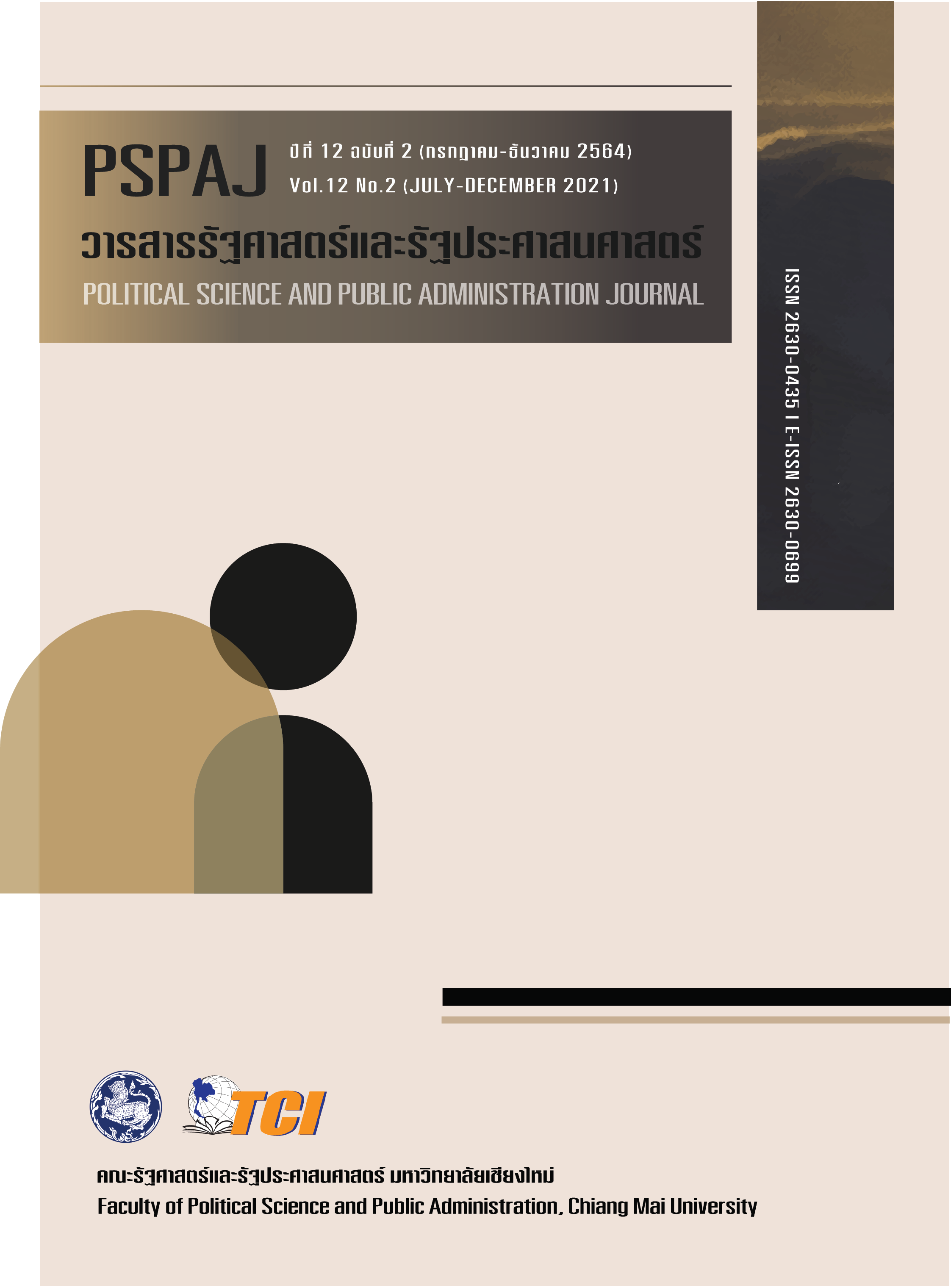Human Resource Management in Public Sector with Employer Branding
Main Article Content
Abstract
Human resource management in each Thai government agency varies according to organizational objective. Organizational strategic planning must coincide with national strategic planning. In Thailand, government agencies face human resource management problems, which may be resolved by using the concept of employer branding, and focusing on caring for public sector employees. Employer branding conveys distinctive details about each organization’s strong points to attract talented and suitable job candidates. Employer branding may also point out factors possibly affecting employee engagement and turnover. Four primary factors are influential: reward and recognition; external reputation, learning and development, and team management. These may principally affect individual decision-making but the weight of each factor varies according to environmental and personal experience.
Article Details
- เนื้อหาและข้อมูลที่ลงตีพิมพ์ในวารสารรัฐศาสตร์และรัฐประศาสนศาสตร์ถือเป็นข้อคิดเห็นและความรับผิดชอบของผู้เขียนบทความโดยตรง ซึ่งกองบรรณาธิการวารสารรัฐศาสตร์และรัฐประศาสนศาสตร์ ไม่จำเป็นต้องเห็นด้วย หรือร่วมรับผิดชอบใดๆ
- บทความและข้อมูล ที่ได้รับการตีพิมพ์ในวารสารรัฐศาสตร์และรัฐประศาสนศาสตร์ ถือเป็นลิขสิทธิ์ของวารสาร หากบุคคลหรือหน่วยงานใดต้องการนำข้อมูลไปใช้ประโยชน์ในทางวิชาการ ขอให้อ้างอิงแหล่งที่มาด้วย
References
กุลวลัย ชัยศรีสุรพันธุ์. (2557). การให้คำปรึกษาเกี่ยวกับการสร้างแบรนด์นายจ้าง บริษัท ABC ฟาร์มา (ประเทศไทย) จำกัด. (สารนิพนธ์บริหารธุรกิจมหาบัณฑิต), มหาวิทยาลัยธรรมศาสตร์.
จรัสศรี วัฒนจัง, พนิดา วัฒนภิโกวิท, และชุติมา พลังวิทย์วัฒนา. (2551). Employer Branding ต่อการสรรหา. (สารนิพนธ์บริหารธุรกิจมหาบัณฑิต), มหาวิทยาลัยธรรมศาสตร์.
เมธินี นิมิตรมงคลชัย. (2555). การศึกษาอิทธิพลของการพัฒนาอย่างยั่งยืนต่อการสร้างแบรนด์นายจ้างในธุรกิจอสังหาริมทรัพย์. (สารนิพนธ์บริหารธุรกิจมหาบัณฑิต),มหาวิทยาลัยธรรมศาสตร์.
วัชรีวรรณ ลือพัฒนสุข. (2561). แนวทางการสร้างแบรนด์นายจ้างของธุรกิจใหม่ในประเทศไทย. (สารนิพนธ์บริหารธุรกิจมหาบัณฑิต), มหาวิทยาลัยธรรมศาสตร์.
วรางคณา งาคู่ปฏิพัทธ์, ณัฐสุดา พัวตระกูลทรัพย์, และกัญจนา บวรรัตนชัย. (2550). กลยุทธ์การสร้างแบรนด์ให้กับนายจ้าง โดยเฉพาะมุมมองด้านการสรรหาพนักงาน กรณีศึกษา บริษัท เจริญโภคภัณฑ์อาหาร จำกัด (มหาชน). (สารนิพนธ์บริหารธุรกิจมหาบัณฑิต), มหาวิทยาลัยธรรมศาสตร์.
สมศักดิ์ เจตสุรกานต์. (ม.ป.ป.). การบริหารทรัพยากรบุคคลภาครัฐแนวใหม่. สืบค้นเมื่อ 7 มกราคม 2563, จาก https://bit.ly/2JOjbtR
สมศักดิ์ เจตสุรกานต์, พิภาวิน ลี้สัมพันธ์, และสิทธิโชค ปรางค์ทอง. (2555). คู่มือระบบค่าตอบแทน สำหรับข้าราชการพลเรือนสามัญ. สืบค้นเมื่อ 7 มกราคม 2563, จาก https://bit.ly/3a6tKn7
สำนักงานคณะกรรมการข้าราชการพลเรือน. (ม.ป.ป.). เป็นข้าราชการ...ได้อะไรมากกว่าที่คุณคิด. สืบค้นเมื่อ 7 มกราคม 2563, จาก https://bit.ly/2V0u1ni
______. (2552). คู่มือการดำเนินการสรรหาและเลือกสรรพนักงานราชการ. สืบค้นเมื่อ 6 เมษายน 2563, จาก https://bit.ly/3c4gO2n
______. (2562). ผลการสำรวจความคิดเห็นและความพึงพอใจเกี่ยวกับการบริหารทรัพยากรบุคคล ประจำปีงบประมาณ พ.ศ. 2561 ของข้าราชการพลเรือนสามัญในภาพรวม. สืบค้นเมื่อ 9 เมษายน 2563, จาก https://bit.ly/2y9Yw0I
สำนักวิจัยและพัฒนาระบบงานบุคคล สำนักงานคณะกรรมการข้าราชการพลเรือน. (2561). (ร่าง) มาตรการพัฒนาระบบบริหารทรัพยากรบุคคลภาครัฐเพื่อรองรับสังคมสูงอายุ. สืบค้นเมื่อ 7 เมษายน 2563, จาก https://bit.ly/2xjPxu2
อารีย์ รุ่งแสง. (ม.ป.ป.). การบริหารทรัพยากรณ์มนุษย์ภาครัฐ. สืบค้นเมื่อ 2 เมษายน 2563, จาก https://bit.ly/2URkIpB
Alnıaçık, E., Alnıaçık, Ü., Erat, S., & Akçin, K. (2014). Attracting Talented Employees to the Company: Do We Need Different Employer Branding Strategies in Different Cultures? Procedia-Social and Behavioral Sciences, 150, 336-344.
Ambler, T., & Barrow, S. (1996). The Employer Brand. Journal of Brand Management, 4(3), 185-206.
Barrow, S., & Mosley, R. (2011). The Employer Brand: Bringing the Best of Brand Management to People at Work. N.P.: John Wiley & Sons.
Bellou, V., Chaniotakis, I., Kehagias, I., & Rigopoulou, I. (2015). Employer Brand of Choice: An Employee Perspective. Journal of Business Economics and Management, 16(6), 1201-1215.
Chambers, E. G., Foulon, M., Handfield-Jones, H., Hankin, S. M., & Michaels, E. G. (1998). The War for Talent. McKinsey Quarterly, (3), 44-57.
Cooper, J. (2018). Top Human Capital Challenges for Public Sector HR: Highlights from the Public Sector HR 2018 Conference. Retrieved April 4, 2020, from https://bit.ly/34ymJu8
Dutton, J. E., Dukerich, J. M. & Harquail, C. V. (1994). Organizational Images and Member Identification. Administrative Science Quarterly, 39, 239-263.
Jain, V., & Pal, R. (2012). Importance of Employer Branding in Business Up-gradation. International Journal of Research in IT & Management, 2(11), 68-75.
Morris, R. (2016). How Can a Strong Employer Brand Support Recruitment in the Public Sector? In Citron, L. (Ed.). The Government & Public Sector Practice (pp. 29-39). N.P.: WPP.
Reichenberg, N. (2002). Branding the Government as an Employer of Choice. Retrieved April 3, 2020, from https://go.aws/2V20YzB
Stariņeca, O. (2015). Employer Brand Role in HR Recruitment and Selection. Economics and Business, 27(1), 58-63.
Temporal, P. (2015). Branding for the Public Sector: Creating, Building and Managing Brands People Will Value. Chichester, West Sussex: John Wiley & Sons.


